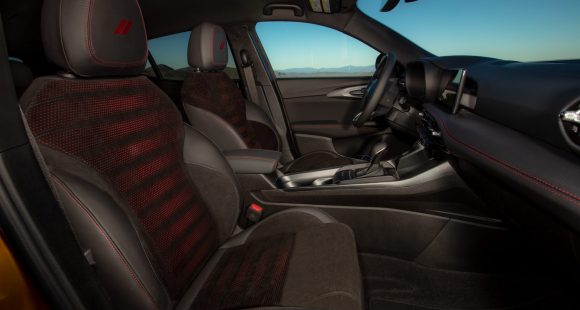2024 Dodge Hornet R/T
The PHEV That You Expect Dodge To Build
Dodge prides itself in being a performance-first brand. So, it was no surprise that when they re-joined the compact crossover segment last year, they did so with the most powerful utility vehicle you could buy for under $30,000. Well, it turns out they were just getting started as now they’re really cranking things up with the Hornet R/T. So, let’s see if its electrifying performance really stings.
By now you’ve probably heard about Dodge’s big EV plans for the near future, including the 670-horsepower Charger battery-electric muscle car. But it’s this 2024 Dodge Hornet R/T that will go down in the history books as the first-ever electrified performance vehicle from the brand.
It’s not fully electric of course, but it is a plug-in hybrid. And, when we talk about PHEVs, most people tend to think about environmental impact and getting more bang for the buck. But there’s another side to some PHEVs, a dark and sometimes scary high-performance side, and as you can imagine, it’s in these shadows that this Dodge lives.
The Hornet R/T ditches the standard Hornet GT’s 2.0-liter turbo for a hyperactive 1.3-liter turbo-4, then adds 90 kW of electric boost for a total output of 288 horsepower and 383 lb-ft of torque. The all-wheel-drive setup is unique as well, as that e motor is mounted in the rear, handling power distribution strictly to the rear wheels. The whole setup is mostly the same as the one found in the Alfa Romeo Tonale that we tested last year, though both horsepower and torque numbers are slightly higher here in the Dodge.
Still, our track day at Mason-Dixon Dragway coincided with near triple digit summer heat and humidity and it sucked some of the sting out of our Hornet. We couldn’t quite match Dodge’s claimed 5.6-second 0-60 time, or the 5.9-second run we saw in the Tonale. But, 6.3 seconds to 60 is still pretty quick for a small ute, with a quarter-mile of 15.0 seconds flat at 90 mph. Holding back the R/T’s paddle shifters engages the cool PowerShot function, which delivers a 30-horsepower boost for up to 15 seconds.
Performance was more spirited in our handling course, where quick and responsive steering had us flying through the cones with ease.
Ironically, the Hornet R/T’s 128 mph top speed is actually down from the GT’s 140, mostly due to having three fewer gears in the transmission, six instead of nine, along with all of the extra hardware and weight that comes along with having an electric motor and plug-in battery. Fortunately for us, Performance was more spirited in our handling course, where quick and responsive steering had us flying through the cones with ease. Koni frequency selective dampers are standard in the Hornet, but getting max performance does require an upgrade; the optional Track Pack adds 20-inch wheels and a Dual Stage Valve Suspension. There was some body roll, but we were able to push very hard without stability systems stepping in. An initial tendency to understeer was quickly cured by adding a little throttle which lets the rear motor’s torque join the party. And in that vein, when you select EV mode, the R/T operates as strictly a rear-wheel-drive vehicle, something few other small crossovers can do.
And even with this PHEV’s added electrified weight, the R/T’s standard Brembo brakes stopped us in a very short 99 feet. There was some nosedive, but also a very smooth feeling pedal with almost no ABS pulsing.
While track performance is entertaining, the R/T feels even spunkier when driving around town, where the sharp throttle response had it taking off quicker than you’re expecting. Feeding in even moderate amounts of throttle will toss you back in your seat a bit. What fun! And speaking of the normal daily drive, you can travel a great 33-miles on the battery alone. Diving deeper, we liked the overall nicely refined nature of the R/T’s interior as well. Leather seating and Harmon Kardon sound are added if you upgrade to the R/T Plus.
Government Fuel Economy Ratings are 29-Combined… a realistic number and 20% higher than the non-hybrid Hornet with 77-Combined for the MPGe. All for a great Energy Impact Score, using just 4.0 barrels of oil annually, with 2.0 tons of CO2 emissions.
Dodge Hornet pricing starts at $32,995; the R/T is another 10-grand on top of that, and a few option packages can push it over $50,000.
So yes, we have a little bit of a hard time wrapping our minds around spending that kind of money for any small crossover. But, compared to European performance utilities that closely match its spec sheet, that price is not unreasonable. Think of the 2024 Dodge Hornet R/T as a unique way to join the plug-in revolution, with an unexpectedly big PowerShotting fun-to-drive factor included. Clearly, Dodge still understands the kind of total performance that Americans love.
Specifications
As Tested
- Engine: 1.3-liter turbo-4
- Transmission: 6-speed automatic
- Battery Size: 15.5 kWh
- EV Range: 33 miles
- Horsepower: 288
- Torque: 383 lb-ft
- 0-60 mph: 6.3 seconds
- 1/4 Mile: 15.0 seconds at 90 mph
- 60-0 Braking: 99 feet (avg)
- EPA: 29 Combined MPG | 77 Combined MPGe
- MW Fuel Economy: 27.3 MPG


































